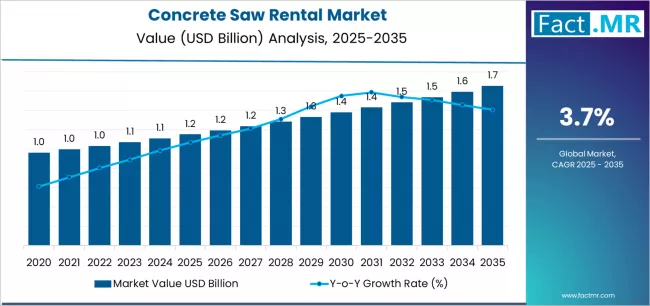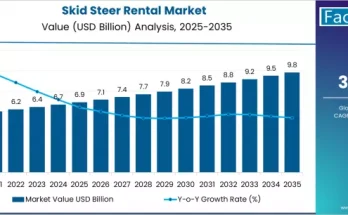The global concrete saw rental market is forecast to grow steadily over the next decade, driven by rising construction activity, infrastructure modernization, and increasing adoption of rental models for specialized cutting equipment. The market is expected to expand from USD 1,150 million in 2025 to approximately USD 1,650 million by 2035, representing a compound annual growth rate (CAGR) of 3.7%.
Key Market Highlights
-
2025 Market Value: USD 1,150 million
-
2035 Forecast Value: USD 1,650 million
-
Projected CAGR (2025‒2035): 3.7%
-
Leading Type Segment: Handheld saws (~45% share)
-
Top Application: Cutting (~55% share)
-
Primary Power Source (2025): Gas-powered saws (~50%)
-
Key Growth Regions: Asia-Pacific, North America, Europe
-
Major Players: Husqvarna, United Rentals, Sunbelt, HSS
To Access the Complete Data Tables & in-depth Insights, Request a Discount on this report: https://www.factmr.com/connectus/sample?flag=S&rep_id=8638
Major Growth Drivers
-
Booming Construction & Infrastructure Work
Increasing investments in infrastructure and commercial development are driving demand for compact and efficient rental cutting tools. -
Rental as a Cost-Effective Equipment Strategy
Contractors prefer renting concrete saws for project-based needs—especially for specialized or infrequent tasks—rather than owning expensive, maintenance-intensive saws. -
Urban & Tight-Space Applications
Handheld skid saws, valued for their mobility and maneuverability, are ideal for urban settings and confined job sites, boosting their rental appeal. -
Dust Control & Safety Regulations
Regulatory pressure around silica exposure is pushing rental providers to offer saws equipped with integrated dust collection or wet cutting systems for safer operation. -
Growth in Infrastructure and Road-Work Projects
Beyond standard building construction, road maintenance and utility work require reliable cutting tools for expansion joints and surface modifications—fueling demand for walk-behind and gas-powered rental units.
Market Segmentation
-
By Type
-
Handheld Saws: The dominant segment due to ease of handling and mobility.
-
Walk-Behind Saws: Used for heavy-duty cutting and larger construction tasks.
-
Wall / Wire Saws: Specialized for precision cutting, supported by advanced cutting needs.
-
-
By Application
-
Cutting: Leading use-case across construction, roadwork, and utility installation.
-
Demolition: Growing demand in urban redevelopment and renovation.
-
Roadwork: High-value, precise cutting needs in infrastructure projects.
-
-
By Power Source
-
Gas: Dominant in 2025 for its operational independence and mobility.
-
Electric: Preferred for indoor projects, where emissions and noise matter.
-
Hydraulic: Used in specialized, high-power cutting applications.
-
Regional Outlook
-
Asia‑Pacific: Major growth expected due to rapid infrastructure development and rising rental adoption in construction.
-
North America: Mature rental market with high demand for flexible, short-term equipment usage.
-
Europe: Increasing use of specialized rental tools driven by renovation, road maintenance, and urban construction needs.
Challenges & Risks
-
Fleet Utilization: Rental companies must carefully manage inventory to balance demand during off-peak and peak construction seasons.
-
Maintenance Costs: Frequent use and high-stress cutting applications require regular maintenance, raising operational expenses.
-
Regulatory Burden: Rental providers need to ensure compliance with safety standards, emissions norms, and operator training.
-
Capital Intensity: Building a robust rental fleet with specialized saw types requires significant investment.
Competitive Landscape
Rental operators and equipment manufacturers are focusing on:
-
Increasing their concrete saw fleet, especially lightweight and handheld models
-
Offering specialized attachments, blade options, and cutting packages
-
Using telematics systems to track usage, maintenance, and utilization
-
Introducing flexible rental terms (daily, weekly, project-based)
-
Expanding geographically in high-growth markets
Leading companies like Husqvarna, United Rentals, Sunbelt, and HSS are leveraging their scale and service capabilities to meet rising demand.
Strategic Recommendations
-
Expand Short-Term Rental Fleet: Enhance availability of handheld and walk-behind saws to meet peak project demand.
-
Introduce Telematics & Tracking: Implement hour meters and GPS to manage maintenance and predict demand.
-
Offer Specialized Rental Packages: Bundle saws with blades, safety gear, and dust-control attachments.
-
Grow in Emerging Markets: Target Asia-Pacific and rapidly developing regions to capitalize on infrastructure growth.
-
Promote Compliance & Safety: Educate customers about dust control, safety upgrades, and regulatory requirements.
Browse Full Report: https://www.factmr.com/report/concrete-saw-rental-market
Market Outlook
The concrete saw rental market is set to strengthen significantly over the next decade as construction and infrastructure continue to scale globally. With projected growth to USD 1.65 billion by 2035, there is strong opportunity for rental firms, contractors, and fleet operators.
Stakeholders who invest in specialized equipment, adapt to safety and dust-control standards, and optimize fleet utilization are likely to lead in this increasingly professionalized and compliance-driven market.
About Fact.MR:
Fact.MR is a global market research and consulting firm, trusted by Fortune 500 companies and emerging businesses for reliable insights and strategic intelligence. With a presence across the U.S., UK, India, and Dubai, we deliver data-driven research and tailored consulting solutions across 30+ industries and 1,000+ markets. Backed by deep expertise and advanced analytics, Fact.MR helps organizations uncover opportunities, reduce risks, and make informed decisions for sustainable growth.



